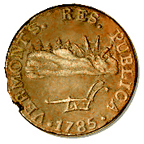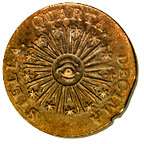Vermont copper facts for kids
Vermont coppers were special copper coins made by the Vermont Republic a long time ago. These coins were first made in 1785. They kept making them until 1791, when Vermont joined the United States and became the State of Vermont.
Contents
Making Vermont's First Coins
On June 10, 1785, leaders in Vermont had a meeting. They were called the House of Representatives. They needed to decide if a man named Reuben Harmon Jr. could make copper coins for Vermont. Vermont's Governor's Council also joined the discussion.
Just a few days later, on June 15, 1785, the group agreed. They said Reuben Harmon Jr. could be the only person to make copper coins in Vermont for two years. The coins had to weigh at least one-third of an ounce. On June 17, 1785, Harmon agreed to the rules. He then started his mint, which is a place where coins are made, near Hagar's Brook in Rupert.
Coin Designs and Mottos
The same group of leaders also chose the sayings, called mottos, and the pictures for the coins.
Early Designs: Mountains and Stars (1785-1786)
The first coins from 1785 and 1786 had a special picture on the front, called the obverse. It showed the Sun rising over the Green Mountains with a plow in front. Around this picture, it said VERMONTS. RES. PUBLICA. in Latin. This means "the republic, or commonwealth, of Vermont."
The back of the coin, called the reverse, looked a lot like an earlier American coin from 1783. It had a large star with rays coming out, and an eye inside it. This was surrounded by 13 smaller stars. Around these stars, it said STELLA QUARTA DECIMA, which means "the 14th star." Later coins changed the front motto slightly, using words like VERMONTIS. RES. PUBLICA. or VERMONTENSIUM. RES. PUBLICA.
New Designs: People and Liberty (1787-1788)
In October 1785, Reuben Harmon Jr. asked for more time to make coins. He got an extension for eight more years, starting July 1, 1787. The new agreement described a very different coin design.
The front of these new coins had a picture of a person's head, called a bust. Around the bust, it said AUCTORITATE VERMONTENSIUM. This Latin phrase means "by authority of Vermont." The back of the coin showed a woman sitting down. It had the words INDE ET LIB, which is short for "independence and liberty."
These new coins looked very much like the British halfpenny coins used in America at that time. The British coin had a picture of King George III on the front. The back showed a seated woman representing Britain, called Britannia. Vermont's coins were made to look similar. This made it easier for them to be used and traded outside of Vermont.
What the Symbols Mean
The laws from 1785 described the coin designs in detail. However, there are no old notes explaining why these specific pictures or mottos were chosen. Experts who study coins, called numismatists, have offered their ideas about what the symbols mean.
The Sun rising over the Green Mountains might mean peace. It could also suggest that God approved of Vermont. The plow likely stands for farming, which was very important in early Vermont. It might also remind people of Cincinnatus. He was an ancient Roman farmer who left his farm to help Rome, then returned to his plow.
The large star with an eye, seen on the 1785 and 1786 coins, is similar to a common symbol called the Eye of Providence. This symbol often suggests an all-seeing God. In this case, the large star might represent Vermont itself. The 13 smaller stars probably stood for the 13 American states that already existed. The motto STELLA QUARTA DECIMA, or "the 14th star," showed Vermont's hope to become a state too.
The seated woman on the back of the second coin design was based on the Britannia figure from British coins. A similar seated woman is also on the coat of arms of Vermont. She is sometimes called Agriculture or Ceres, who was the Roman goddess of farming.



